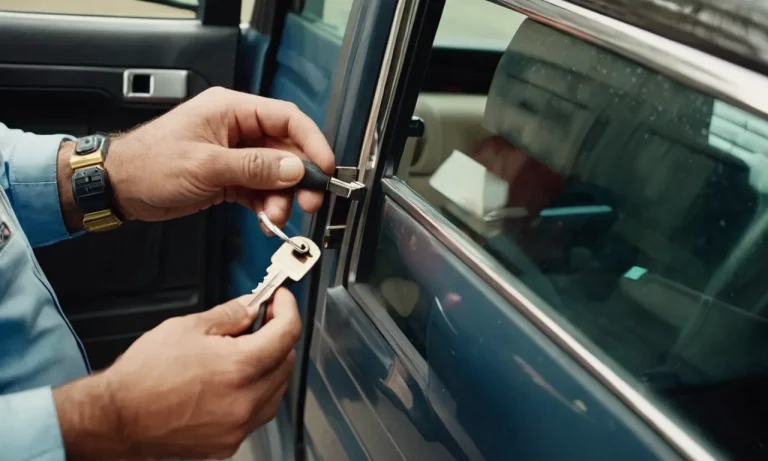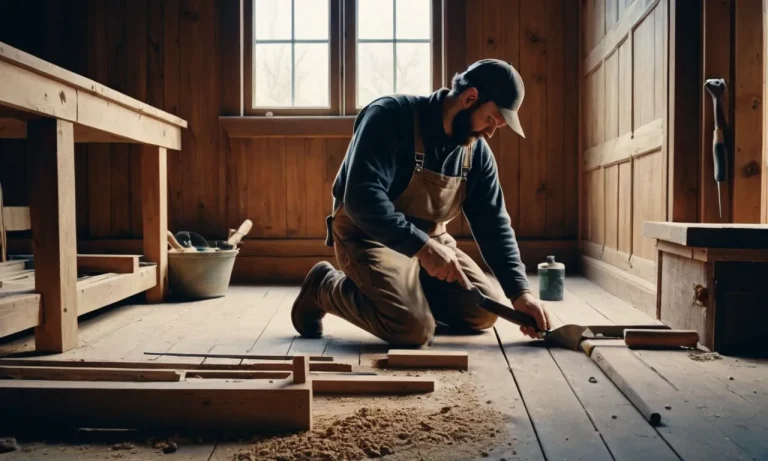How To Get Your Sliding Glass Door Back On Track
A sliding glass door that jumps the track or won’t slide smoothly can be frustrating. This comprehensive guide will walk you through all the steps needed to diagnose the problem and get your sliding door working properly again.
If you’re short on time, here’s a quick answer to your question: Adjust the rollers, clean the track, and lubricate all moving parts to get a sliding glass door back on track.
In this roughly 3000 word guide, we’ll cover common reasons a sliding glass door comes off track, how to determine the specific problem with your door, steps for fixing minor issues like dirty tracks and misaligned rollers, instructions for resetting a door that’s completely derailed, and maintenance tips to prevent issues in the future.
What Causes a Sliding Glass Door to Come Off Track?
A sliding glass door can come off track for several reasons. Understanding these causes can help you prevent future issues and ensure your door operates smoothly. The most common reasons for a sliding glass door to come off track include:
1. Loose, damaged, or worn rollers
Rollers play a vital role in the smooth operation of a sliding glass door. Over time, they can become loose, damaged, or worn out, causing the door to come off its track. Regular maintenance, such as tightening screws and lubricating rollers, can help prevent this issue.
2. Bent or damaged tracks
The tracks on which the door slides can become bent or damaged due to various factors, including heavy use, impact, or improper installation. When the tracks are not in their proper shape, the door may derail. In some cases, professional repair or replacement of the tracks may be necessary.
3. Out of alignment from improper installation
Improper installation can lead to a sliding glass door being misaligned, causing it to come off track. If the door was not installed correctly or has shifted over time, it may need to be realigned by a professional. This ensures that the door moves smoothly along its track.
4. Dirt, debris, or lack of lubrication
Accumulated dirt and debris can hinder the movement of the sliding glass door, causing it to come off track. Additionally, lack of lubrication can increase friction and make it difficult for the door to slide smoothly. Regular cleaning and lubrication can help prevent these issues.
By understanding the causes of a sliding glass door coming off track, you can take proactive measures to prevent this issue. Regular maintenance, proper installation, and keeping the tracks clean and lubricated are key to ensuring the smooth operation of your sliding glass door.
Diagnosing the Exact Problem
When your sliding glass door is not functioning properly, it’s important to diagnose the exact problem before attempting any repairs. By identifying the root cause of the issue, you can effectively address it and get your door back on track. Here are some steps to help you diagnose the problem:
Inspect the rollers and ensure they spin freely
One common cause of a sliding glass door malfunction is worn-out or damaged rollers. Start by examining the rollers located at the bottom of the door. Check if they spin freely or if they are sticking. If the rollers are not spinning properly, they may need to be replaced.
According to Home Depot, you can find replacement rollers at your local hardware store.
Check for damage or debris along the track
Another issue that can affect the smooth operation of your sliding glass door is damage or debris along the track. Inspect the track carefully for any signs of dents, bends, or obstructions. If you notice any damage, you may need to repair or replace the track.
Additionally, make sure to clean out any debris that may be causing the door to get stuck. A clean track can significantly improve the sliding action of the door.
Test the door sliding – does it stick at certain spots?
As you slide the door open and closed, pay attention to any sticking points. If the door seems to get stuck or drag at certain spots along the track, there may be an alignment issue. Misalignment can occur due to various reasons, such as loose screws or a warped frame.
In such cases, you may need to adjust the alignment or seek professional help to get it back on track.
Look for sagging or misalignment issues
Lastly, examine the overall alignment of the sliding glass door. If you notice any sagging or misalignment, it could be a result of loose hinges or a damaged frame. Tighten any loose screws and check for any visible damage.
If the misalignment persists, it’s best to consult a professional to avoid further complications.
Remember, diagnosing the exact problem is crucial to effectively resolving any issues with your sliding glass door. By following these steps, you can identify the root cause and take the necessary steps to get your door back on track.
Fixing Minor Issues
Adjusting loose rollers
If you find that your sliding glass door is not moving smoothly or is getting stuck, the problem may lie with the rollers. Over time, the rollers can become loose or misaligned, causing the door to come off track.
To fix this issue, you can adjust the rollers by locating the adjustment screws on the bottom of the door. Use a screwdriver to tighten or loosen the screws until the door glides smoothly along the track.
Cleaning dirty tracks
One common issue that can cause a sliding glass door to become difficult to open or close is dirt and debris in the tracks. Over time, dirt, dust, and other particles can accumulate in the tracks, causing the door to drag or stick.
To clean the tracks, start by removing any loose dirt with a vacuum or a soft brush. Then, use a damp cloth or sponge to wipe away any remaining debris. For stubborn dirt or grime, you can use a mild detergent or a mixture of vinegar and water.
Once the tracks are clean, dry them thoroughly to prevent any moisture from causing rust or damage.
Lubricating rollers and track
Regular lubrication is essential to keep your sliding glass door operating smoothly. Lubricating the rollers and track helps reduce friction, preventing wear and tear on the components. Silicone-based lubricants are recommended for this task, as they provide long-lasting lubrication without attracting dirt or debris.
Apply a small amount of lubricant to the rollers and track, making sure to distribute it evenly. Be careful not to over-lubricate, as excess lubricant can attract dirt and cause the door to become sticky.
Aligning a slightly misaligned door
If your sliding glass door is slightly misaligned, it may not slide smoothly along the track. To align the door, start by examining the top and bottom tracks to ensure they are straight and level. If you notice any bends or warping, you may need to replace the track.
If the tracks are in good condition, you can adjust the door’s alignment by loosening the screws on the top and bottom of the door frame. Gently push or pull the door until it is parallel with the frame, and then tighten the screws to secure it in place.
Remember, these are general guidelines for fixing minor issues with sliding glass doors. If you encounter more significant problems or are unsure about any of the steps, it is always best to consult a professional.
They will have the expertise and tools necessary to diagnose and repair any issues with your sliding glass door.
Resetting a Completely Derailed Door
Removing the door from the frame
If you find that your sliding glass door has completely derailed, the first step is to remove it from the frame. This can be done by locating the screws or bolts that hold the door in place and using a screwdriver or wrench to loosen them.
Once the screws or bolts are removed, carefully lift the door off the track and set it aside. It’s important to be cautious during this step to avoid any damage to the door or injury to yourself.
Inspecting rollers and track for damage
After removing the door, closely inspect the rollers and track for any signs of damage or wear. Look for cracks, dents, or excessive dirt and debris that may be causing the derailment. Clean the track thoroughly using a soft brush or cloth, and remove any obstructions that may be preventing the door from sliding smoothly.
If the rollers are damaged or worn out, they may need to be replaced.
Replacing damaged parts
If you notice any damaged rollers or track components during the inspection, it’s important to replace them before rehanging the door. You can find replacement parts at your local hardware store or online.
Make sure to choose the correct size and type of rollers or track components for your specific sliding glass door model. Follow the manufacturer’s instructions for installation, or consult a professional if you’re unsure.
Rehanging and realigning the door
Once you have replaced any damaged parts and ensured that the track is clean and clear of obstructions, it’s time to rehang the door. Carefully lift the door back onto the track, making sure that the rollers fit securely into the groove.
Once the door is in place, tighten the screws or bolts to hold it firmly in position. Test the door by sliding it back and forth to ensure that it moves smoothly along the track. If needed, make any necessary adjustments to realign the door.
Resetting a completely derailed sliding glass door may seem like a daunting task, but with the right tools and a little patience, it can be done. Remember to take your time, inspect for any damage, and replace any worn-out parts.
By following these steps, you’ll have your sliding glass door back on track in no time!
Maintenance Tips
Lubricate on a regular schedule
One of the key maintenance tasks for keeping your sliding glass door on track is regular lubrication. Over time, dirt and debris can accumulate in the track, causing the door to become difficult to slide.
To prevent this, it is recommended to lubricate the track and rollers every six months or as needed. Use a silicone-based lubricant or a dry lubricant spray specifically designed for sliding glass doors. Apply the lubricant to the track and rollers, wiping away any excess.
This will help the door glide smoothly and prevent unnecessary wear and tear.
Inspect rollers and track periodically
Regular inspection of the rollers and track is essential to ensure that everything is in good working condition. Check the rollers for any signs of wear or damage. If the rollers are worn out or misaligned, they can cause the door to come off track.
Replace any damaged or worn-out rollers as soon as possible. Additionally, inspect the track for any obstructions or debris that may hinder the movement of the door. Clear away any dirt or debris using a soft brush or cloth.
This simple maintenance task can prevent issues and extend the lifespan of your sliding glass door.
Keep bottom track clear of debris and moisture
The bottom track of your sliding glass door is prone to collecting dirt, debris, and moisture. This can lead to rusting, corrosion, and damage to the track, affecting the smooth operation of the door. To prevent this, make sure to regularly clean the bottom track.
Use a vacuum cleaner or a soft brush to remove any dirt or debris. Wipe the track with a damp cloth to remove any moisture. It is important to keep the bottom track dry and free from obstructions to ensure that the door slides effortlessly.
Adjust rollers as needed
If you notice that your sliding glass door is not sliding smoothly or is coming off track, it may be necessary to adjust the rollers. Most sliding glass doors have adjustable rollers that can be adjusted using a screwdriver or an Allen wrench.
Refer to the manufacturer’s instructions or consult a professional for guidance on how to properly adjust the rollers. By making the necessary adjustments, you can restore the smooth operation of your sliding glass door.
By following these maintenance tips, you can keep your sliding glass door working properly and avoid costly repairs. Remember to regularly lubricate the track, inspect the rollers and track, keep the bottom track clear of debris and moisture, and adjust the rollers as needed.
Taking care of your sliding glass door will ensure its longevity and enhance the functionality of your space.
Conclusion
Following this comprehensive guide will equip you to diagnose any sliding glass door issue, make minor repairs and adjustments yourself, and determine if professional help is needed for major repairs. With proper maintenance and care, your sliding door should operate smoothly for years to come.







